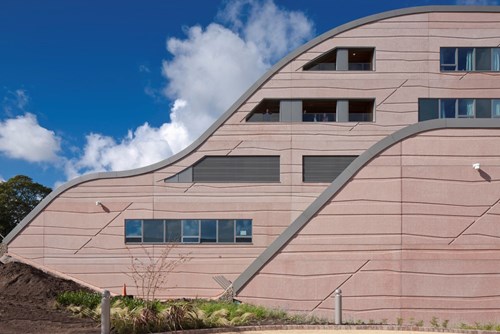
Insights into BDP’s expertise and the future of hospital design, infection control and patient focused environments.

Image courtesy of BDP 2021©
Part two of our in-depth interview with Ged Couser of BDP. Ged talks about healthcare buildings and hospital development. He discusses BDP’s approach to hospital design strategy and working with NHS infection control specialists for a safer future.
In part one, Ged discussed his role in the ultra-rapid rollout of Nightingale hospitals and how he was isolated from his family for weeks during the process. He also described how, after the risks he faced, he contracted Covid-19 some time afterwards. The harrowing detail of his experience reinforced his views on infection control and healthcare design and construction.
Earlier in the interview, you discussed how attitudes towards infection had been changing in hospital design – can you recap your thoughts on this?
It has been an extraordinary time. Covid-19 has showed how pandemics can arise with terrifying speed and could have the potential to put enormous pressure on our healthcare systems. It is becoming clear that a number of unprecedented measures need to be adopted by governments and societies around the world. But effective vaccines produced at incredible speed really are critical.
Vigilance and infection prevention will be a key part of the future for all of us. This won’t be the last time we see global pathogens. It’s been over 100 years since the last pandemic in 1918 (H1N1 virus) which infected something like 500 million people worldwide, with the terrible tragedy of at least 50 million deaths. The way we design hospitals and healthcare facilities will be based around key principles of infection prevention through design, processes and materials. Infection prevention specialists also focus on the spread of secondary diseases. This is where the science of healthcare design comes to the fore for hospital designers such as BDP.

Image courtesy of BDP 2021©
How would you describe the way hospital design has changed in recent times?
Trusts are rethinking the way hospitals work from the ground up. They have become more patient experience centred and use the latest thinking in aiding recovery through highly effective design. A good example is BDP’s approach to the recently completed Alder Hey Children’s Hospital in Liverpool. The Trust gave us a very ambitious and unusually innovative brief. It was visionary really, but still had to be centred around clinical functionality. They wanted a‘children’s healthpark’and wanted to incorporate therapeutic design ideas - with lots of greenery and uplifting views. We aimed to create a hospital that doesn’t look like a hospital.
I’m particularly struck by your Alder Hey Children’s Health Park project. I was an outpatient at Alder Hey when I was small and remember the old Victorian building and the whole experience being really frightening – it felt like a labyrinth.
Yes, the old building was very institutional in its character. High windows and tiled corridors, etc. The new Alder Hey is the polar opposite. It is designed to be full of light, fresh air, colour and art. A much more cheerful place than the old building that you were bound to find overwhelming, especially as a child. We also understand a lot more about the link between environment and patient wellbeing. People get better more quickly when they can see the sky, trees and life. The relationship between these and recovery is understood far better. It also means patients spend less time in hospital beds and interestingly, need fewer painkillers.
Being a ‘Scouser’, I really enjoyed the way the cladding reflected the Liverpool red sandstone I grew up around.
Yes - we worked closely with the contractor, Laing O’Rourke to achieve that contextual feel, reflect the heritage of the area.

Image courtesy of Velfac 2021©
Are there other innovations that have been developed?
Yes. in particular, circulation and facilities management works are radically different. For example, circulation patterns are much clearer and more obvious. Also, there’s a clear separation between people and movement of supplies and equipment. This makes it much less stressful for people who are perhaps a bit anxious when they see some of the operational stuff that may seem intimidating. It’s fascinating to see the automated guided vehicles deliver supplies and material throughout the hospital in basement circulation links.
Previously you talked about the subtle but critically important change in how infection is managed, can you tell us a bit more about that?
In the past, the specialists talked about 'infection control’. This has changed to 'infection prevention' These specialists have deep insights on the methods of how some people get ill from infections. Especially the risk of picking up illnesses in hospital. They know about the suffering and pain of patients and their loved ones through extensive personal experience.
Their job is to understand where pathogens that can be a problem can linger. Our work with them is about eliminating such risks as far as possible and designing accordingly.
Once again, it’s about understanding how design, details and materials choice can be effective in preventing the riskof hospital acquired infections.

Critical care area. Image courtesy of BDP 2021©
There is much more choice in building products these days – antimicrobial ironmongery and contact free taps. Also wall and door materials etc. Do you consider such innovations in your approach?
Anything that can passively help control and prevent infection is a good idea. It’s not just about Covid-19, but lots of other things like seasonal flu and rhinoviruses (common cold) too. We will use what works and saves lives. They can also contribute to decreasing the length of stays on hospital wards and ICU’s.
Ged – Thanks so much again for sharing your insights and experience. It definitely creates confidence if I’m ever a patient!
My pleasure!
Book a CPD
Sign up to a Riba approved CPD presentation on 'The Principles of Surface Protection' brought to you by 

 NBS Specification
NBS Specification Book a CPD
Book a CPD